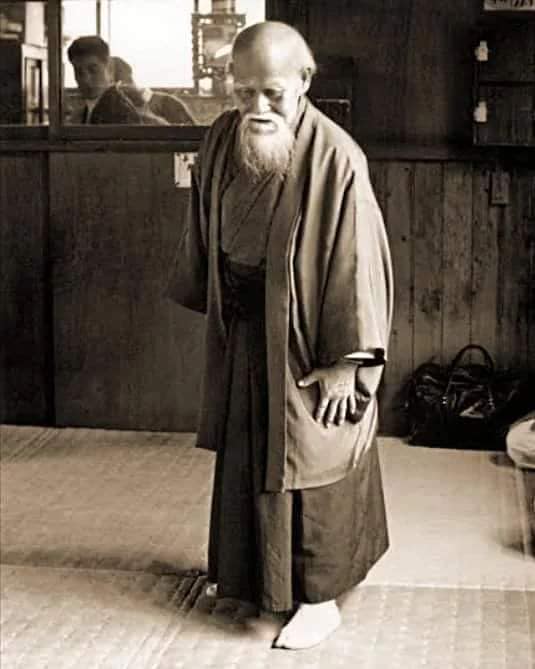
“The key element in this worldview is musubi, which means something like “connection” or “unity.” In classical Japanese texts like the Kojiki and the Nihonshoki, the word musubi is written using a pair of characters meaning “generation/birth” and “spirit/soul.” The first character, “musu,” connotes generative change, for example in phrases like “gohan wo musu” (to steam rice, in which the rice undergoes a qualitative change) and “koke ga musu” (the imperceptible and seemingly spontaneous growth of moss). The second character, “bi” (or “hi”), refers to a holy or sacred spirit. Together, these refer to the emergence and growth of things from the natural order and fabric of the cosmos.
Aikido, in my opinion, is what happens when this musubi-based worldview is given martial expression.
My feeling is that aikido, and by extension martial arts in general, offers a form of “love.” There is a film of Takuma Hisa taken at the Asahi News dojo back in 1935. He is reading from the Domon, which begins: “Budo should be considered a means of following the sacred path of the Divine, a spiritual path leading toward fulfillment of the Divine Mission to create a greater world of infinite absolute goodness, truth, and beauty.”
Comparing Ueshiba Sensei’s technique in the film with that of his latter years, he himself said, “My technique was poor then.” Many of his techniques involved repelling opponents backward.
In other words, clashing was involved. In aikido, we shouldn’t clash with each other. We should pass by each other.
Have you ever head the word “ainuke” (mutual passing through)?
What do you think would happen if two experts passed by each other in the street. In the case of “aiuchi”(mutual striking), both of them would be dead. In reality, there would be difference in their abilities, one of them would be hurt.
But if experts pass by each other, neither of them will be hurt.
This is called “ainuke”.
A person called Sekiun Harigaya12 in the Edo period first mentioned this, “The essence of Japanese budo is ainuke.”
In any event, this was supposed to be an ideal.
In aikido, the best outcome is for two people to pass each other in a flash, the encounter immediately being ended. Neither is killed.
Tesshu Yamaoka progressed from Itto-ryu to Muto-ryu.
Despite the strenuous practice of kendo, he abandoned his sword. When one attacks you with a sword suddenly, you seize his sword in a flash with empty hands. That was supposed to be the best kendo. It’s hard to reach that stage. Anyway, killing is the worst possible result.”
Shigenobu Okumura Shihan
